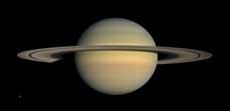SI Units |
Earth Relative |
|
Radius (Equatorial) |
60,268,000 m |
9.4492 x Earth |
Mass |
5.6846 x 1026 kg |
95.152 x Earth |
Temperature (Surface Mean) |
88 K (-185 °C) |
|
Gravity |
3.69 ms-2 |
0.376 g |
Escape Velocity |
35,600 ms-1 |
|
Axis Tilt |
26.7° |
|
Distance from Sun (Semi-Major) |
1.43344937 x 1012 m |
9.582 AU |
Orbital Period |
29.46 Earth Years |
|
Rotational Period |
0.44 Earth Days (10.2 Hours) |
|
Number of Moons |
200+ (61 with confirmed orbits, 53 with names): including
Mimas, Enceladus, Tethys, Dione, Rhea, Titan, Iapetus
|
|
Atmosphere |
97% Hydrogen, 3% Helium |
|
Rings |
135,000,000 m in radius, 300 m thick. Mostly ice particles.
4 main ring groups: (outwards in) A, B, C, (Cassini division), D
|
|
Missions to Saturn |
Pioneer 11, Voyager 1, 2, Cassini-Huygens |
|
